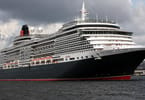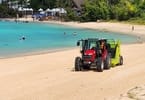A study of bottlenose dolphins living off the coast of Zanzibar has found that the many tourist boats operating in the area are harassing the animals, preventing them from resting, feeding and nurturing their young.
The research, led by Dr Per Berggren of Newcastle University, also highlighted swimming with dolphins – in particular where tourists swim in very close and try to touch the dolphins – as being incredibly stressful for the animals.
This is the reason why tourists wanting to watch and swim with dolphins are now being urged to keep their distance in a bid to protect both the animals and the local communities whose livelihoods depend on them.
According to the researchers, regulation of the dolphin tourism industry is “urgently needed” to minimize the potential long-term negative impact on the animals.
“The current situation in Zanzibar is unsustainable. The local community is dependent on tourism – and therefore the dolphins – but unless the activity is regulated the animals will leave,” Dr Berggren said.
“Our study found that whenever the tourist boats were present the dolphins were very unsettled and spent less time feeding, socialising or resting. This has a negative impact, not only on individual animals, but on the population as a whole and long term it could be devastating,” he said.
“The problem is that any change needs to be tourist-driven. Many visitors will pay drivers extra in tips to steer their boats in close, herding the dolphins so they can dive right in amongst them. Our message is, keep your distance and put the dolphins first,” he added.
Watching the dolphins over a period of 40 days, the research team found that in the presence of the tourist boats, the time the dolphins spent resting dropped from 38 per cent of the time to 10 per cent while the time they spent foraging and socialising dropped from 19 and 10 per cent to just 10 and 4 per cent, respectively.
Meanwhile, travelling behaviour more than doubled in proportion, from 33 to 77 per cent, becoming by far the most dominant activity state during interactions with tourist boats.
“Overall, the dolphins are using more energy than they are taking in because they aren’t resting or feeding as much but are swimming more as they try to avoid the tourist boats,” explained Dr Berggren.
WHAT TO TAKE AWAY FROM THIS ARTICLE:
- Watching the dolphins over a period of 40 days, the research team found that in the presence of the tourist boats, the time the dolphins spent resting dropped from 38 per cent of the time to 10 per cent while the time they spent foraging and socialising dropped from 19 and 10 per cent to just 10 and 4 per cent, respectively.
- This is the reason why tourists wanting to watch and swim with dolphins are now being urged to keep their distance in a bid to protect both the animals and the local communities whose livelihoods depend on them.
- A study of bottlenose dolphins living off the coast of Zanzibar has found that the many tourist boats operating in the area are harassing the animals, preventing them from resting, feeding and nurturing their young.






















